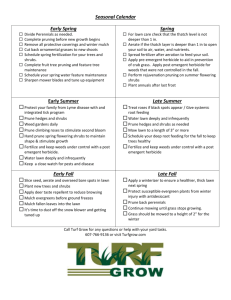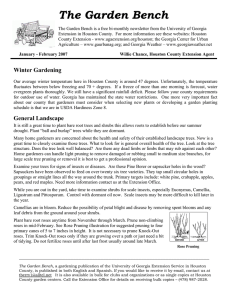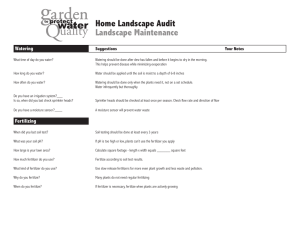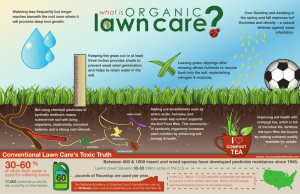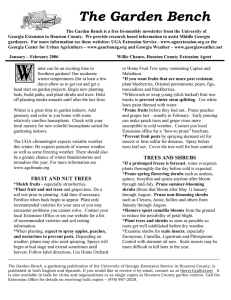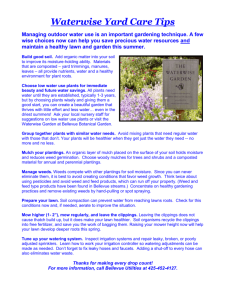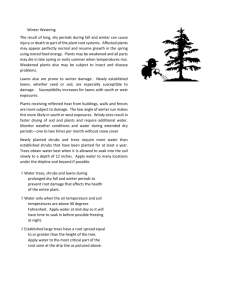The Garden Bench
advertisement
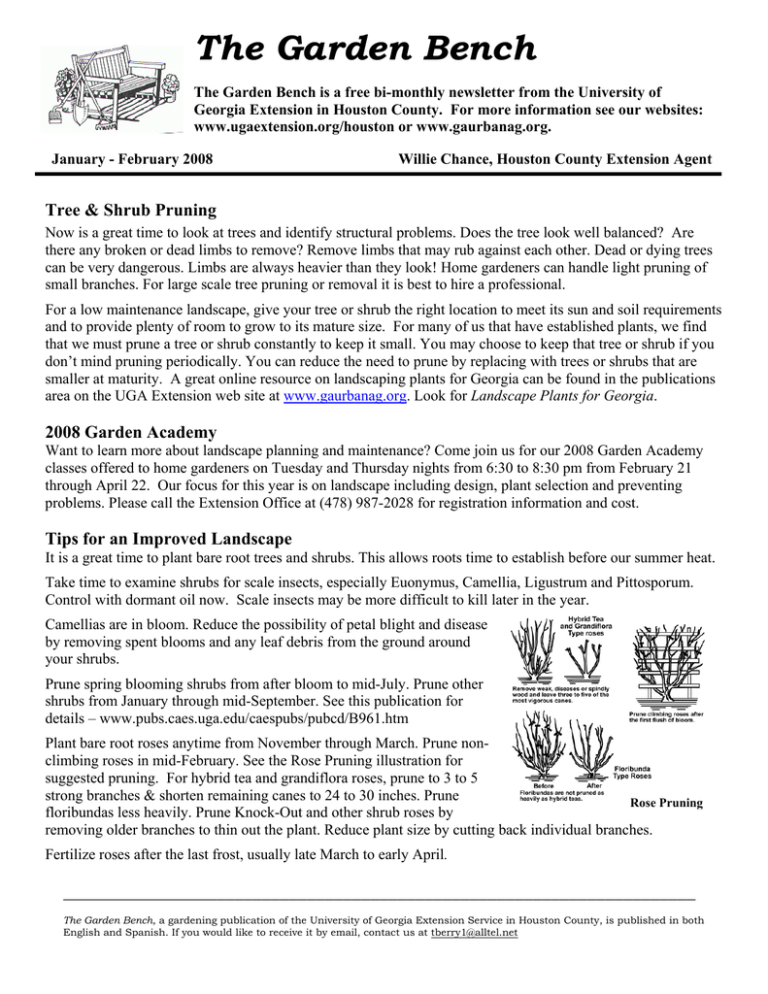
The Garden Bench The Garden Bench is a free bi-monthly newsletter from the University of Georgia Extension in Houston County. For more information see our websites: www.ugaextension.org/houston or www.gaurbanag.org. January - February 2008 Willie Chance, Houston County Extension Agent Tree & Shrub Pruning Now is a great time to look at trees and identify structural problems. Does the tree look well balanced? Are there any broken or dead limbs to remove? Remove limbs that may rub against each other. Dead or dying trees can be very dangerous. Limbs are always heavier than they look! Home gardeners can handle light pruning of small branches. For large scale tree pruning or removal it is best to hire a professional. For a low maintenance landscape, give your tree or shrub the right location to meet its sun and soil requirements and to provide plenty of room to grow to its mature size. For many of us that have established plants, we find that we must prune a tree or shrub constantly to keep it small. You may choose to keep that tree or shrub if you don’t mind pruning periodically. You can reduce the need to prune by replacing with trees or shrubs that are smaller at maturity. A great online resource on landscaping plants for Georgia can be found in the publications area on the UGA Extension web site at www.gaurbanag.org. Look for Landscape Plants for Georgia. 2008 Garden Academy Want to learn more about landscape planning and maintenance? Come join us for our 2008 Garden Academy classes offered to home gardeners on Tuesday and Thursday nights from 6:30 to 8:30 pm from February 21 through April 22. Our focus for this year is on landscape including design, plant selection and preventing problems. Please call the Extension Office at (478) 987-2028 for registration information and cost. Tips for an Improved Landscape It is a great time to plant bare root trees and shrubs. This allows roots time to establish before our summer heat. Take time to examine shrubs for scale insects, especially Euonymus, Camellia, Ligustrum and Pittosporum. Control with dormant oil now. Scale insects may be more difficult to kill later in the year. Camellias are in bloom. Reduce the possibility of petal blight and disease by removing spent blooms and any leaf debris from the ground around your shrubs. Prune spring blooming shrubs from after bloom to mid-July. Prune other shrubs from January through mid-September. See this publication for details – www.pubs.caes.uga.edu/caespubs/pubcd/B961.htm Plant bare root roses anytime from November through March. Prune nonclimbing roses in mid-February. See the Rose Pruning illustration for suggested pruning. For hybrid tea and grandiflora roses, prune to 3 to 5 strong branches & shorten remaining canes to 24 to 30 inches. Prune Rose Pruning floribundas less heavily. Prune Knock-Out and other shrub roses by removing older branches to thin out the plant. Reduce plant size by cutting back individual branches. Fertilize roses after the last frost, usually late March to early April. ______________________________________________________________________ The Garden Bench, a gardening publication of the University of Georgia Extension Service in Houston County, is published in both English and Spanish. If you would like to receive it by email, contact us at tberry1@alltel.net Lawns Weeds in lawns now are usually leftover winter weeds. Weed control is difficult once weeds get large. You can spray broadleaf weeds with Weed-B-Gon, 33-Plus, or equivalent. Expect poor control when using herbicides on large or blooming weeds. You may want to just mow the weeds and collect clippings before seeds form. To control wild onion and garlic in your lawn, use two sprays of chemicals containing imazaquin four weeks apart. Prevent summer weeds. Apply a pre-emergence weed killer in mid-February and again 45 days later. You can use Atrazine for all lawns except Bermuda grass. Halts (containing pendamethalin), Balan (benefin), Surflan (oryzalin) and XL can be used on all warm season lawn grasses. Do not use these if you plan to seed your lawn within 45 to 60 days or during lawn green-up. Contact the Extension Office or see our pesticide handbook (www.ent.uga.edu/pmh/Hm_Turf.pdf ) or read the pesticide label to see which weeds each one controls. Take a soil test and add lime if needed. Do not lime lawns unless recommended by a soil sample. Over-liming can raise pH too high and damage lawns – especially centipede lawns. Check lawns for thatch problems. Remove thatch layers thicker than one-half inch (one inch for St. Augustine lawns). De-thatch the lawn in January or February. Do not de-thatch lawns once they begin to green up. Flowers Fertilize bulbs when the plant gets two to three inches tall. Apply one pound of 10-10-10 per 100 square feet, or another equivalent fertilizer. Keep the soil moist but not overly wet. After the bloom dies, do not cut off the foliage until it turns brown. These leaves replenish the bulb’s food supply for next year’s bloom. To increase bloom and color, continue deadheading and fertilizing pansies. Prepare flower beds for warm season annual flowers. Do a soil test and add lime and fertilizer as needed. Plant frost tender flowers in late March or early April, weather permitting. Vegetables / Herbs Plan your garden and prepare soil for planting. Plow two or more inches of compost into the soil. Added organic matter improves the fertility, physical structure and water-holding capacity of the soil. Take a soil sample now to allow 10 days to get the report back. Always use dolomitic limestone if lime is needed. It contains more magnesium – an important plant nutrient. For winter and early spring plantings, use raised beds for better drainage and earlier soil warm-up. Put plenty of mulch between the rows to control weeds. Plant English peas and onion sets or plants now. Plant Irish potatoes from March 10 through mid-April. You can also plant asparagus, carrots, collards, cabbage, lettuce, mustard, radish, spinach, turnip and a few other vegetables. For a complete vegetable gardening planting calendar see the last page of this publication online http://pubs.caes.uga.edu/caespubs/pubcd/B577.htm Start seeds of vegetables. Give seedlings plenty of light. Place them in a south-facing window, outside in a hothouse or greenhouse or inside within 12 to 18 inches of a fluorescent light. The University of Georgia and Fort Valley State University, the U.S. Department of Agriculture and the counties of the state cooperating. The Cooperative Extension Service offers educational programs, assistance and materials to all people without regard to race, color, national origin, age, sex or disability. An equal opportunity/affirmative action organization committed to a diverse work force.
